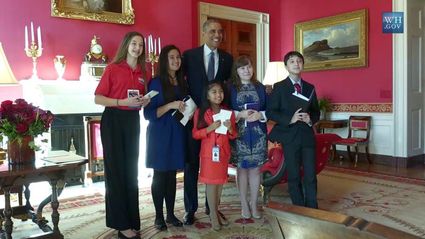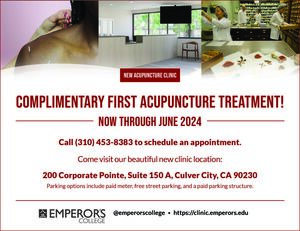Culver City Teen Meets President
Meeting Includes White House Officials at Education Summit
December 11, 2014

Standing in front of President Barack Obama (L-R) Ainsley Felter, Scholastic News Kids Press Corp (age 13); Julie Vadhan, Huffington Post Teen (age 14); Lily Scott, Time For Kids (age 8); Tess Harkin, Student Voice (age 17); Culver City's Sam Parekh, KidScoop Media (age 13)
(EDITOR'S NOTE: Sam Parekh is a student at Culver City Middle School
By Sam Parekh
Special to the Observer
On Wednesday, November 19, I was one of five youth reporters invited to the White House for a ConnectED conference involving superintendents from schools across the nation.
ConnectED is President Obama's initiative to bring high-speed internet access to 99% of schools and increase innovative technology use in American schools. The other young journalists represented Time for Kids, Scholastic News, Student Voice, and HuffPost Teen. I was reporting for KidScoop Media, as I have many times in the past, though never at the White House.
We first asked questions of Cecilia Muñoz, Director of the Domestic Policy Council for the President, and found her very receptive to them. Some questions asked were (not direct quotes): "How is ConnectED going to try to catch up to South Korea's program of modernization in the classroom?" and "Teachers are often unfamiliar on how to capitalize on technology's abilities. How can you and the Department of Education fix this?" One of my questions was, "An important part of studying history is having a multiplicity of viewpoints. A single textbook is inadequate to that requirement. How do you envision the Internet helping better the curriculum in Social Studies and History classes?" Ms. Muñoz answered that the Internet can help by providing free and easy-to-find texts which all present different viewpoints. In addition, you don't have to try to flip through a book to find the relevant section, Google will just bring it up for you.
Questions like these were asked by kids ranging from a senior in high school to a child only eight years old. I fell about in the middle, at 13 years of age, and being a seventh grade student. Interestingly enough, I was the only boy out of five, and from the farthest away (Los Angeles/Culver City).
Then we were taken to the Red Room of the White House, where we were met by the Assistant Secretary of Education, Deborah Delisle. After talking to us about our school's level of technology, which ranged wildly, from a computer-per-student, to an outdated computer lab of 40 computers and a single cart of Google Chromebooks, several other people came in, including Ms. Hope, President Obama's personal videographer, and Arne Duncan, the Secretary of Education.
Opal, our guide, announced after Mr. Duncan left that President Obama was going to meet with us for 5-10 minutes. We had been told it was a possibility we would meet the President, but with his schedule there were no guarantees. All of us must've thought, "Holy cow! We're going to meet the PRESIDENT!"
We had about 20 minutes before he came, so we all started scribbling down questions for him. When he arrived he said, casually, "Sorry I'm late!" with a grin. We all laughed and then he said, "I hear you hard-hitting reporters have some questions for me. Who would like to go first?"
I raised my hand. My question was: "How do the goals of Common Core fit with the goals of ConnectED, and will there be a major revision, or even a complete replacement of Common Core?"
The President answered that Common Core was a unified code of education that governors agreed upon to raise the bar on achievement. He added, "ConnectED and Common Core have one thing in common: to prepare America's youth for the future."
The senior in high school, Tess, asked about how FCC regulations concerning a school's connectivity to the Internet would be impacted by ConnectED; the HuffPost Teen reporter was next; then the little girl, who, panicked, and said "I don't have a question for you."
The President then said, "Well, can I still talk to you?" The President asked her a few questions, then moved onto the 8th grader, Ainsley, who asked, "How is ConnectED going to try to bring Internet connectivity to remote areas, like the island of Molokai?"
The President answered her question, then asked why she had used that particular example, whereupon she revealed that she had lived on Hawaii for a time, and had visited the island she talked about, and spoke from experience on how hard it was to get Wi-Fi on Molokai.
When the President had finished answering our questions he moved on, and the Marine officer in the room told us, "If we move really fast, we can catch his speech in the East Room. Follow me, single-file."
So we moved through the Blue and Green Rooms, to come out near the back of the East Room, where all the other press was congregated. We watched the President's speech, some of us taking notes but most of us, including me, recording it with our phones. After the President finished speaking, everyone except us left the room.
The Chief of Food and Drink, who has worked at the White House for over 20 years, let us ascend the podium and take pictures where Obama had been speaking, with a State-of-the-Union-style podium in front of him.
We were then led out to the annex where we began, retrieved our coats, and exited the White House grounds.

















Reader Comments(1)
StudentRights writes:
Please see the twitter page for details (https://twitter.com/ComputeriseExam). I am fighting for Students Rights in India. A NITK student committed suicide recently due to FEAR that Rogue Professors will do academic dishonesty & Professional Misconduct to deliberately fail him. I was deliberately failed FOUR TIMES twenty years ago. No other student should suffer the way I suffered. Can you put me in touch with Sam Parekh or anybody else who can share ideas on how to go about getting job done?
07/14/2019, 8:30 pm